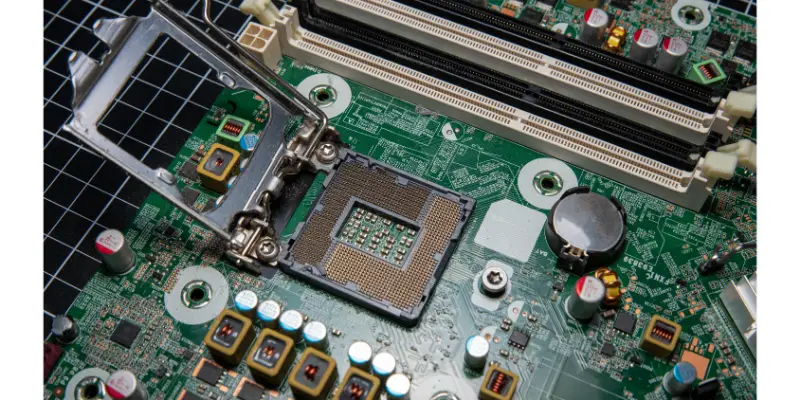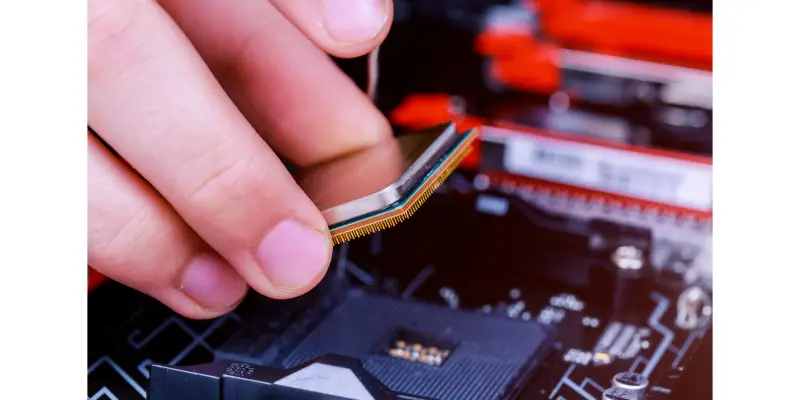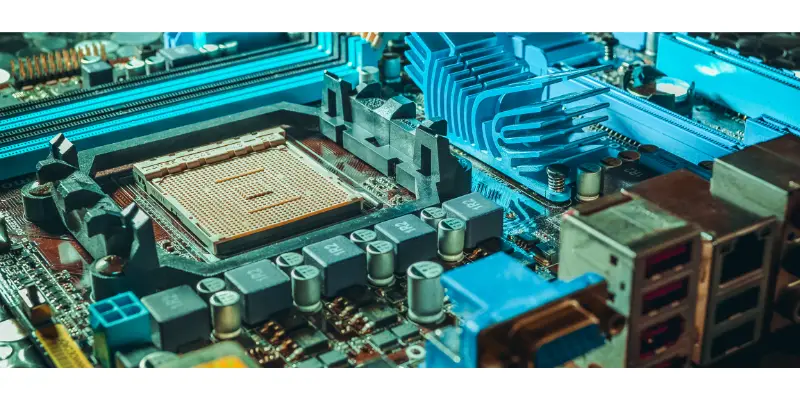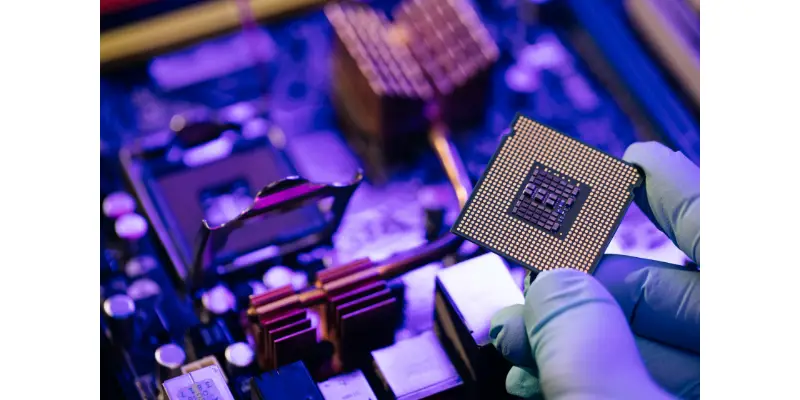Disclaimer: This post may contain affiliate links, meaning we get a small commission if you make a purchase through our links, at no cost to you. For more information, please visit our Disclaimer Page.
The motherboard is one of the essential elements of a computer. But, like any other part, it can become faulty because of a factory error no matter how expensive it is. When this happens, can you quickly test it without a CPU?
You can test the motherboard without a CPU, but only if it only has certain features. Such include the post-on-self-test, which allows you to check the issues with the motherboard, and it also requires LED lights for the process. The feature is, however, only available in high-quality motherboards.
You can test for specific features in the motherboard without having to power on the CPU. In this article, I will discuss how you can do it, what happens if you boot the PC without a motherboard, or whether a dead CPU can kill a motherboard, among other things.
Table of Contents
Can You Test a Motherboard Without a CPU?
If your motherboard is not working, it will cause many different issues with your computer. It, therefore, necessitates looking for the problem in it to fix it. But, one thing most people are unsure about is whether they can test the motherboard for working without the CPU.
Testing the motherboard without the CPU is one way to diagnose any issues and check for its faults quickly. It is imperative to check the motherboard before installing the CPU to get a clear definition of the issue and not confuse the CPU with the issue rather than the motherboard. Technically, it will be hard to test for issues in the motherboard once you finish building the whole PC.
The ability to test the motherboard without the CPU depends on various factors. But one thing that should remain prevalent when testing is that the testing will not go through if it lacks the Power-on-self-test (POST) feature. However, for several recent motherboards, you can test them even though they lack this feature.
Such motherboards can perform BIOS updates even without connecting them to the CPU. It is therefore clear that you can power and perform tests on your motherboards without the CPU. One way you can test for your motherboard is by turning it on, and when it does, the LED lights in it should light up.
Also, once you power up the motherboard with the help of the power-on-self-test, all the case fans will ignite. In this case, you should be able to see the cooling fans rotate. The LED lights are lighting up, and the cooling system whirling indicates that the motherboard is in good condition up to this point. However, you have to be sure that the components will work once you install the CPU back to work alongside the motherboard.
If the LED lights are working and the cooling system is in action, typically, this may not be proof that the motherboard will work on all levels. Therefore, the need to check whether it will still work after putting the CPU back or instead once you finish building your PC. At this point, the internal speakers on your motherboard should come in handy.
Most if not all motherboards come with internal speakers in them. Or maybe you have the speakers attached to the exterior speaker. Either way, when powering on the motherboard, you should hear it beeping several times.
The beeping, or rather the “beep codes,” indicates that the motherboard is trying to detect the CPU. If this is the case, you can then conclude that the motherboard is working well. It also shows that it will ultimately be able to connect to the CPU once you install it.
However, in some motherboards, they will not produce the beep sound when connecting to the CPU. It should not mean that the motherboard is not working. It may be because they lack internal speakers.
In some motherboards, they will also produce the beeping sound if you power it up without RAM. It is also a good indication that it is working well. So, it goes down to checking whether the motherboard can light up, whether the cooling systems are still working, and checking whether it produces the beeping sound.
In some motherboards, such as those people use for gaming, you can test their functionality through a multimeter. Well, this may work, but considering how delicate the motherboard is, it may not be a viable option. Using a multimeter to test the motherboard will take so much of your time, and it is also not as easy.
It is possible to test your motherboard without the CPU. And most of the steps you can take to test for it are pretty much straightforward. However, it is essential you verify whether the motherboard will work once you connect the CPU to ensure there are no issues with it.
Can a Dead CPU Kill a Motherboard?
There are many reasons your motherboard can die. However, you should know that if your CPU is already dead, it is not likely to kill the motherboard. If the CPU is dead, it means that it is not functioning at all, which means that it will not pose any problems to the motherboard or any other computer parts.
While a dead CPU cannot, in reality, kill a motherboard, it can damage it. If the CPU is dead, it tends to consume so much power. This consumption will, in turn, destroy the voltage regulation modules, and it may also result in burning some parts of the motherboard.
Also, a dead CPU tends to fry the socket because of the much power it consumes. If the CPU was shorting to the ground, it could blow up several things, including the motherboard. But it will not necessarily kill it and what can kill the motherboard is maybe when you fail to install it correctly.
Moreover, a motherboard may die if it is subjected to electrical shocks or has any physical damage. Also, it will die if there is excess heat in it but rarely because of a dead CPU. Usually, when connecting the CPU, you do so directly into the motherboard without fitting it in the socket, which reduces the chance of it damaging.
When the CPU over-stresses the components that connect to it, and it happens to damage, the damage may spread even outside the CPU itself, implying that the damage will reach even the motherboard. However, the damage the CPU causes will vary depending on the type of connection you have.
For instance, there are instances where you connect the CPU directly to the motherboard without attaching it to the socket. Such is the case in things like laptops and tablets. In this case, if the CPU damages, you may need to replace even the motherboard.
It is because the damage in the CPU may cause direct and equal damage to the motherboard. It is, therefore, cheaper than trying to fix the CPU alone. If you are dealing with a multi-CPU system and the CPU dies, the motherboard may not die.
Therefore, most times, using a dead CPU causes direct harm to the motherboard. The damage is due to the slow and short circuits that occur when the CPU dies. You may not see this with time, but at some point, you will notice some traces of burns in your motherboard. However, it should not imply that the motherboard is dead, but should knock in some sense that you need to be careful with it or best if you replace it immediately.
Even though many reasons can kill motherboards, they may never die to a dead CPU. One of the main reasons it can go wrong is the excess electrical shock that it may experience. Remember, motherboards are the ones that help in transferring electricity to other parts of the computer.
Therefore, if there is an issue with the electricity, it will first affect it before transferring the damage to other parts of the computer, such as the CPU. The motherboard may also die from overheating and physical damage such as rapturing of the capacitors. It may be hard to escape some of these problems, but you can take the necessary precautions to protect the motherboard.
What happens if you Boot a PC without a CPU?
There may be a point where your computer will not boot at all. It will require you to carry out some diagnostics to solve the issue. When trying to boot your PC, you can take everything out of it but do not touch the CPU.
The CPU functions as the brain of a human being such that if you remove the brain in humans, they will not function at all. The same case applies to CPU’s in computers, if you remove the CPU from the computer, you cannot start it, and mainly all the processes in the computer will stop working. However, in some cases, the problem may be the CPU itself, which may leave you wondering whether you can test without it.
You may need to determine if the motherboard is the cause of the problem in your computer or may need to update the BIOS. All these issues will require the CPU to check, but can you do it without it? What about turning it on? Will I be able to do so without the CPU?
Well, it is close to impossible to perform any computer diagnostics without the CPU. Before you purchase your computer, you should first ensure that you check if there is a CPU. Check if it is functioning well and if it is in good condition.
Usually, when the computer goes for the power-on–self–test, it first starts to check on the CPU. If there is no CPU, it will not boot at all. You may try to boot your PC without the CPU, the process may be successful, but you can be sure that it will not wholly boot unless you attach it to the CPU.
When booting the PC, it does not imply that it will not power up. You can always power the computer up without the CPU using the power-on-self-test routine. The LED lights on the motherboard will ignite, meaning that it is in good condition.
If the motherboard can power up, you can also verify the working condition of the fans and the PSU in the PC. And most times, powering up the motherboard will mean that they are working. Moreover, if you are dealing with a high-quality motherboard, you can go ahead and update the BIOS in it without even installing the CPU.
But when it comes to booting the computer, you can never do it without installing the CPU. The CPU is the computer’s brain; therefore, the computer is as good as dead without it. The computer will not serve you any purpose, not even posting anything without the CPU, but you can turn it on, and you will see the lights in it on and the fans spinning, just that.
Some gamers may try to boot the gaming motherboard without the CPU. Doing this will damage the motherboard because there is nothing the PC can do without the CPU. Well, this may be the case in most motherboards also.
However, some people claim that you can boot the Pc without the CPU. They argue that if your motherboard fails to boot without the CPU, it may be because it has some issues. But this is just a myth because no computer can ever function without the CPU, and what it does is only turn on, spin the cooling system and produce the beeping sound. It will not do any other thing past this.
Can a Bad Motherboard Fry a CPU?
A lousy motherboard can fry a CPU. This case is unlike the case where you are dealing with a faulty CPU, it rarely causes damage to the motherboard, and when it does, you will have to replace the whole PC altogether. There are various possible reasons why the motherboard can fry the PC.
Usually, the motherboard acts as the main connector between almost all the parts of your PC. It allows for the parts of the computer to function well with each other. It is also essential in carrying out various functions such as regulating the power that gets to the computer, regulating the voltage and the current that each part of the computer requires.
If anything comes and enters the motherboard causing it to damage, then it may extend the damage to other parts of the computer, such as the CPU. For instance, if water gets into the motherboard, it will short with the electric current in the computer. As such, the voltage of the electricity will overflow or underflow within the computer, which in turn poses problems to the parts of the computer.
First, the water issue will affect the motherboard. And since it is the one responsible for circulating current to the other parts of the computer, it will cause damage to the CPU or the RAM and other components of the computer. If your motherboard experiences some short-circuiting that may cause damage, mitigate the damage to other parts by detaching them from the motherboard.
But most times, the short circuit will immediately fry even your CPU because it directly connects to the motherboard. Such is mainly the case where you are dealing with laptops or tablets where the CPU is intact with the motherboard such that there is no way you can detach it from it. Therefore when short-circuiting happens, it will affect the CPU instantly.
Another reason why your CPU may fry is when there are some scratches on the motherboard. But mainly, it fries it because of the undervolting or overvolting that may occur when something shorts the motherboard. Or if there are cuts in its tracks, which ends up affecting the whole computer system due to the interconnection between the computer.
In most motherboards frying the CPU, you can only fix it by replacing your whole computer system. It is essential to examine the situation with your motherboard constantly. If you notice that it has some burns on it, disconnect it immediately, and you can also ensure that you connect it to the power outlet that can handle the current it requires to operate.
Once you notice that your CPU is not working or the computer’s brain, you notice that it is not working, then know something is wrong with it. And the most common cause for a not working CPU may be a bad motherboard. Therefore, it is essential to ensure that you check the motherboard first to see if there is any damage to it.
Other than short-circuiting that may cause damage on the motherboard and consequently extend to the CPU, it may also be experiencing some physical problems. Some of these issues may require you to open it up and remove the side panel to examine the motherboard. If you notice that there is some smoke smell in there or maybe the circuit system has some burns, it indicates that the motherboard is not OK and maybe the problem extends even to the CPU.
Also, you need to check the capacitors whose work is to filter the electricity going to the CPU and other parts of the computer. If you find that they are blown up, maybe due to overheating, then it may be why your CPU is not working. You also need to verify if there is a sign of electrolyte leakage in the system.
You need to constantly examine your motherboard and identify some issues that it may be facing. Another way to diagnose your motherboard is by checking how it powers up and down. Suppose the motherboard is constantly powering down, and maybe other components on the computer power up but do not present any live image on the screen. In that case, it indicates that it is not functioning, which may also mean an issue with the CPU.
When the CPU fries due to electrical damage in the motherboard, you also need to check the issue. Usually, most electrical damage starts when you are doing electrical installation, say when installing other peripheral devices. If the person making the installation has some static electricity on their hands, it may discharge the motherboard, which may cause failure on it and the CPU.
Therefore, the motherboard can fry the CPU, and there are many reasons for this. If you can, take the necessary precautions that will help avoid such from happening. Remember, if there is damage to the CPU, then your entire computer system may not function.
Conclusion
You can quickly test a motherboard without a CPU, and you will get various indications that it is working. However, though you can power the PC on without the CPU, it is impossible to boot it; therefore, you will not carry on any processes without it. The CPU and the motherboard usually have a close relationship such that if one fails to work or has some damage in it, it will inflict damage on the other and may fail to work too.





